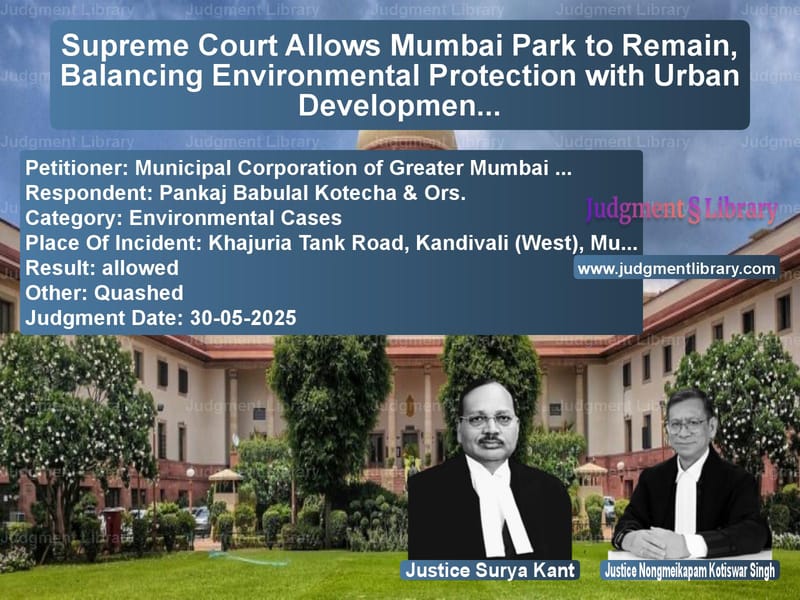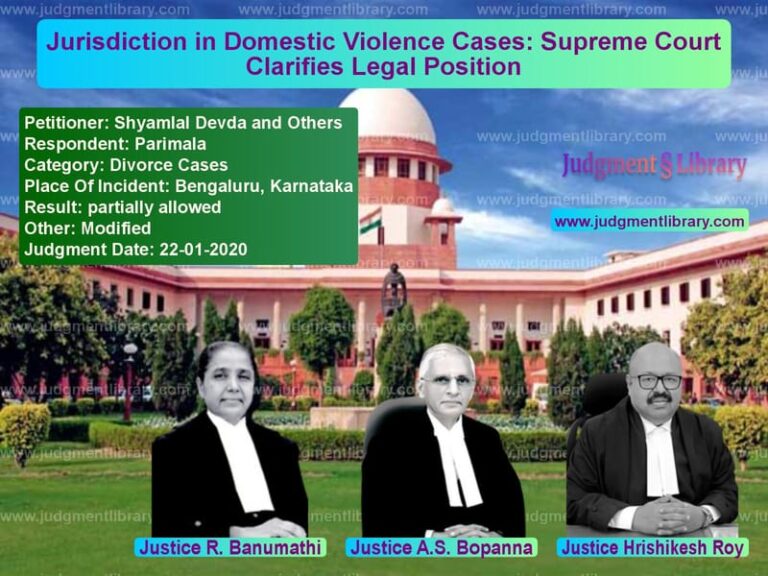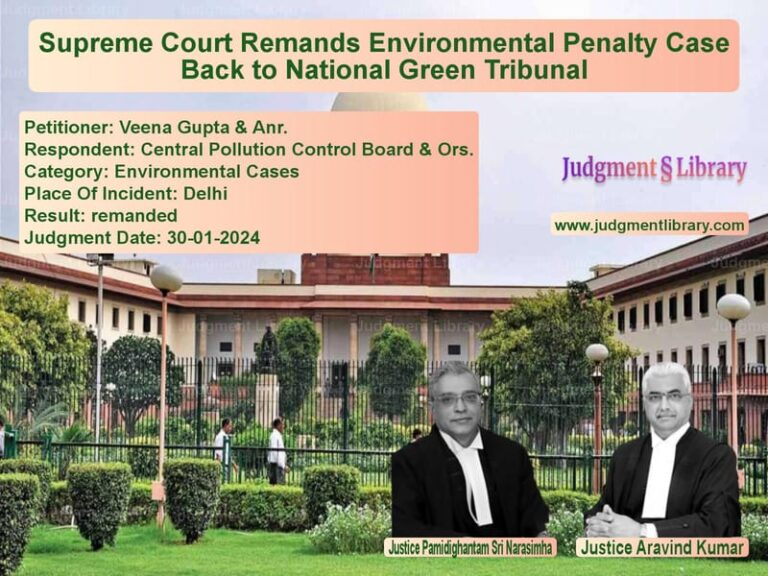Supreme Court Allows Mumbai Park to Remain, Balancing Environmental Protection with Urban Development
In a landmark judgment that carefully balances environmental protection with practical urban development needs, the Supreme Court has allowed a recreational park in Mumbai to remain operational, setting aside the Bombay High Court’s order that had directed the demolition of the park and restoration of an alleged historical lake. The Court recognized that while environmental principles are paramount, they must be applied in context of ground realities and the substantial public benefits created by the existing park.
The case involved the Municipal Corporation of Greater Mumbai’s (MCGM) redevelopment of a theme park on a plot at Khajuria Tank Road, Kandivali (West), Mumbai. The controversy centered around claims that this redevelopment had obliterated a century-old lake that previously existed on the premises. The Bombay High Court, in its 2018 judgment, had accepted these claims and ordered the State Government to take possession of the property, demolish the construction, and restore the lake.
The Legal Battle Over Khajuria Lake
The appellants, Municipal Corporation of Greater Mumbai, represented by learned Senior Counsel Mr. Dhruv Mehta, vehemently contested the High Court’s characterization of the subject property as a lake requiring restoration. The appellants argued that “the Impugned Judgment fundamentally misapprehended the nature of the land by disregarding that the Subject Property was already reserved as Recreation Ground or ‘R.G.’ in the sanctioned Development Plan of 1991.” They emphasized that this reservation was made following due statutory process, including inviting public objections through Gazette Notification dated April 13, 1984, and no objections were ever raised by any party.
The appellants drew attention to the documented usage pattern of the subject property, highlighting that “it had consistently hosted community events, including Ganesh festival celebrations with proper administrative permissions—circumstances incompatible with the existence of a natural lake as alleged by Respondent No. 1.” They detailed how MCGM had transformed what was formerly a degraded area used as a garbage dumping ground into a beneficial public amenity featuring approximately 200 trees, a musical fountain, and recreational facilities, presently serving the local community without charge.
The appellants insisted that “far from constituting illegal construction, the project represents a responsible exercise of MCGM to enhance urban recreational infrastructure, thereby promoting rather than diminishing public welfare in accordance with the Subject Property’s designated purpose.”
The Environmental Concerns
Respondent No. 1, Pankaj Babulal Kotecha, represented by learned Counsel Mr. Kunal Cheema, strenuously opposed the appeal on multiple grounds. He commenced his submissions by challenging the very premise of the development, asserting that “the documentary evidence overwhelmingly established the existence of a functional water body at the Subject Property.” Relying on MCGM’s own correspondence, particularly its letter dated June 30, 2009 seeking permission to convert the ‘Khajuria Talao to that of a municipal garden’, the respondent contended that “such language constituted an unequivocal admission that negated any subsequent attempt to deny the lake’s existence.”
The respondent argued that “the beautification project represented nothing short of ecological destruction, resulting in the obliteration of a century-old lake that supported various aquatic species and attracted diverse birdlife to its surrounding mangroves.” On the aspect of post facto sanction of 2014, the learned Counsel characterized it as “a legally impermissible attempt to retrospectively legitimize an unauthorized act.” He assailed that this sanction, granted during the pendency of litigation and years after the construction’s completion, suffered from inherent contradictions—purporting to approve beautification while simultaneously prohibiting the very change in land use that had already been effected.
Read also: https://judgmentlibrary.com/auroville-township-plan-dispute-supreme-court-overturns-ngt-orders/
In conclusion, the respondent submitted that “the principles of environmental protection and the public trust doctrine mandated the restoration of the natural water body, as rightly held by the High Court.”
The Supreme Court’s Balanced Approach
The Supreme Court bench comprising Justices Surya Kant and Nongmeikapam Kotiswar Singh conducted a thorough analysis of the competing interests. The Court acknowledged that “albeit the High Court’s views were well-intentioned and prima facie the correct interpretation of settled notions such as the public trust doctrine, they nonetheless warrant reconsideration through the prism of practical realities and evolved ground conditions.”
The Court propounded that “environmental jurisprudence must evolve contextually, taking into account both ecological imperatives and developmental exigencies. Indeed, there cannot be a simplistic binary choice between a park or a pond, as each serves distinct ecological and social functions contingent upon specific circumstances, geographical location, and evolving usage patterns.”
The Court elaborated on the public trust doctrine, noting that “although the doctrine imposes a legal obligation upon governmental authorities to protect these resources for public benefit and ecological sustainability, extending to public lands, parks, forests, water bodies, wetlands, and other areas acquired by the State, its application must necessarily be calibrated according to the factual matrix and contemporary public needs. The doctrine, thus, does not operate in isolation but must be harmonized with the objectives of sustainable development and evolving public welfare priorities.”
Critical Factors in the Court’s Decision
The Court examined three critical factors in reaching its decision: (i) the prior condition of the water body; (ii) the current ecological value of the park; and (iii) the feasibility of remedial measures.
Regarding the first factor, the Court found that while the material on record acknowledged the historical existence of a water body, “it does not conclusively establish that this water body remained a functional pond by the relevant time.” The Court noted that “the affidavits filed by officials of MCGM categorically aver that when work for the project commenced in 2009, the Subject Property existed in an abandoned and dilapidated state, having deteriorated into a garbage dumping ground that had completely lost its original character as a water body.” Importantly, the Court observed that “nothing has been pleaded or placed on record to demonstrate that the Subject Property was ever a functional pond with significant water content, possessed any natural catchment area to draw fresh water, or performed meaningful ecological functions beyond occasional ceremonial usage.”
As regards the current ecological value, the Court found that “the photographic evidence placed before us vividly illustrates the Subject Property as a verdant, well-maintained urban oasis replete with numerous mature trees and recreational facilities actively utilized by the community across all demographic segments.” The Court emphasized the temporal aspect, noting that “we are adjudicating this appeal in 2025, nearly fifteen years after the park became functional. During this extended temporal span, an entire generation of children has grown up with this green space as an integral component of their daily existence, whilst the trees planted during the initial beautification have themselves matured into substantial specimens that now contribute significantly to the local ecosystem.”
The Court described how “the park serves as a vital recreational nucleus for children, offering safe spaces for play and physical activity; for senior citizens, providing dedicated areas for walking and social interaction; and for families, creating opportunities for community engagement and leisure.”
The Practical Consequences of Restoration
The Court expressed serious concerns about the practical consequences of implementing the High Court’s direction, stating that “the implementation of the High Court’s direction at this juncture would engender consequences that contravene the very environmental principles it seeks to uphold.” The Court explained that “the demolition would necessitate the removal of numerous trees, causing immediate environmental degradation requiring decades to remediate.” Additionally, “the expenditure of approximately Rs. 5 crores of public funds would be rendered nugatory, with further substantial public expenditure required for the proposed restoration.”
The Court warned that “such an outcome would create a paradox wherein environmental restoration results in greater ecological harm than the original transformation—a classic case of counterproductive remedial intervention.” Most importantly, given the absence of any natural catchment area, the Court observed that “even if a pond were to be recreated, its sustainability and maintenance would remain highly questionable, with the distinct possibility of such stagnant water body becoming health hazards for the local populace, particularly during the monsoon seasons when such properties are prone to becoming breeding grounds for disease-carrying vectors.”
The Issue of Delay and Changed Circumstances
The Court also considered the significant delay in seeking judicial intervention, noting that “the beautification project commenced in 2008 and reached completion by 2011, with the park becoming fully operational for public use. However, the petition was instituted before the High Court towards the tail end of 2012—nearly five years after the project’s commencement and well after its completion.” The Court reiterated the well-settled principle that “environmental grievances must be raised promptly when alleged violations commence, not after transformative changes have materialized and become entrenched.”
The Court found that “this considerable delay has created an irreversible fait accompli wherein substantial public resources have been expended, and a thriving recreational facility has become integral to community life. No public purpose, therefore, would be served by undoing what time and usage have legitimized through community acceptance and reliance.”
The Court’s Final Ruling and Directions
In its conclusive finding, the Court stated: “For the foregoing reasons, we are constrained to hold that the High Court’s direction to restore the Subject Property to its original condition as a pond, though made with laudable intentions, fails to account for the transformed reality and the substantial public benefit derived from the current recreational space.”
The Court allowed the appeal and set aside the High Court’s judgment, while issuing specific directions to ensure ecological balance: MCGM must “maintain and preserve the existing park in perpetuity as a green space exclusively for public use without any predominant commercial activity;”, “constitute an Expert Committee within three months to explore the feasibility of developing an alternative water body in nearby areas to compensate for the ecological functions of the original water body;”, “undertake comprehensive ecological restoration of deteriorated water bodies within the municipal jurisdiction within a period of twelve months;”, and “file a compliance report before the High Court every six months for a period of three years.”
The Court clarified that “the Government, being entrusted with the welfare of public spaces and environmental resources, bears the inherent responsibility to pursue sustainable urban development practices that balance infrastructural needs with ecological preservation.” This judgment represents a significant evolution in environmental jurisprudence, recognizing that while environmental protection remains paramount, it must be balanced with practical realities and the substantial public benefits created by existing developments that have become integral to community life.
Petitioner Name: Municipal Corporation of Greater Mumbai & Ors..Respondent Name: Pankaj Babulal Kotecha & Ors..Judgment By: Justice Surya Kant, Justice Nongmeikapam Kotiswar Singh.Place Of Incident: Khajuria Tank Road, Kandivali (West), Mumbai.Judgment Date: 30-05-2025.Result: allowed.
Don’t miss out on the full details! Download the complete judgment in PDF format below and gain valuable insights instantly!
Download Judgment: municipal-corporatio-vs-pankaj-babulal-kotec-supreme-court-of-india-judgment-dated-30-05-2025.pdf
Directly Download Judgment: Directly download this Judgment
See all petitions in Public Interest Litigation
See all petitions in Judgment by Surya Kant
See all petitions in Judgment by N. Kotiswar Singh
See all petitions in allowed
See all petitions in Quashed
See all petitions in supreme court of India judgments May 2025
See all petitions in 2025 judgments
See all posts in Environmental Cases Category
See all allowed petitions in Environmental Cases Category
See all Dismissed petitions in Environmental Cases Category
See all partially allowed petitions in Environmental Cases Category







